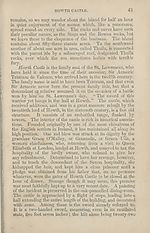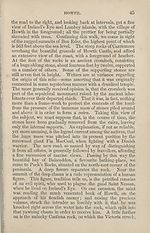Download files
Complete book:
Individual page:
Thumbnail gallery: Grid view | List view

44
EXCURSIONS FROM DUBLIN.
inches long. There are also some good family portraits in the
hall, and other interesting mementos, mcluding the bells from
Howth Abbey. The inscription on one is not very intelligible ;
those on the other two are more so; on one it runs—
Jesu: Christe: Misserere: Nobis:
and on the other—
Sancta : Maria : ora : Pro : Nobis : ad : Filium :
One portrait must not be passed unnoticed, were it only for
the curious adjuncts affixed to it. It is a full length portrait,
by Beridon, in 1735, of Dean Swift, who was a frequent visitor
at the castle. He holds in his hand a paper, on which is
mitten—“ The Draper’s fourth letter to the whole people of
Ireland.” Poor Wood sprawls naked at his f§et, clenching
his patent for the coinage of copper money, a quantity of which
lies scattered about him. The pleasure grounds are extensive,
well laid out, and contain some fine trees. A deep moat
formerly surrounded the castle, but is now almost wholly filled
up.
The Abbey of Howth is situated on a delightful spot
overhanging the ocean. Tradition states that its foundation
was laid in 1235, and that it was erected by Luke, Archbishop
of Dublin, on the removal of the prebendal church from Ireland’s
Eye. It was dedicated to the Blessed Virgin, and hence styled
St. Mary’s. Over the western door is a ruined belfry, and at
the opposite end a triplet window. This is certainly the oldest
portion of the abbey, and undoubtedly the most elegant. In
the chancel is an altar-tomb, belonging to Christopher the
twentieth lord, and his lady Elizabeth. Recumbent figures
represent them both; the former in armour. On the sides of
the tomb are sculptured the arms of the family and its con¬
nections. Along the northern side of the original church, is
an additional aisle, with rounded Burgundian windows, sup¬
posed to belong to the sixteenth century.
The College of Howth is a name given to a peculiar mass
of building, situated close to the burial ground of the abbey.
In the centre is a small court, surrounded with high walled
buildings, now the habitation of the poorer classes.
The Hill of Howth, properly so called, now invites our
attention. Having passed through the village, we keep on by
EXCURSIONS FROM DUBLIN.
inches long. There are also some good family portraits in the
hall, and other interesting mementos, mcluding the bells from
Howth Abbey. The inscription on one is not very intelligible ;
those on the other two are more so; on one it runs—
Jesu: Christe: Misserere: Nobis:
and on the other—
Sancta : Maria : ora : Pro : Nobis : ad : Filium :
One portrait must not be passed unnoticed, were it only for
the curious adjuncts affixed to it. It is a full length portrait,
by Beridon, in 1735, of Dean Swift, who was a frequent visitor
at the castle. He holds in his hand a paper, on which is
mitten—“ The Draper’s fourth letter to the whole people of
Ireland.” Poor Wood sprawls naked at his f§et, clenching
his patent for the coinage of copper money, a quantity of which
lies scattered about him. The pleasure grounds are extensive,
well laid out, and contain some fine trees. A deep moat
formerly surrounded the castle, but is now almost wholly filled
up.
The Abbey of Howth is situated on a delightful spot
overhanging the ocean. Tradition states that its foundation
was laid in 1235, and that it was erected by Luke, Archbishop
of Dublin, on the removal of the prebendal church from Ireland’s
Eye. It was dedicated to the Blessed Virgin, and hence styled
St. Mary’s. Over the western door is a ruined belfry, and at
the opposite end a triplet window. This is certainly the oldest
portion of the abbey, and undoubtedly the most elegant. In
the chancel is an altar-tomb, belonging to Christopher the
twentieth lord, and his lady Elizabeth. Recumbent figures
represent them both; the former in armour. On the sides of
the tomb are sculptured the arms of the family and its con¬
nections. Along the northern side of the original church, is
an additional aisle, with rounded Burgundian windows, sup¬
posed to belong to the sixteenth century.
The College of Howth is a name given to a peculiar mass
of building, situated close to the burial ground of the abbey.
In the centre is a small court, surrounded with high walled
buildings, now the habitation of the poorer classes.
The Hill of Howth, properly so called, now invites our
attention. Having passed through the village, we keep on by
Set display mode to:
![]() Universal Viewer |
Universal Viewer | ![]() Mirador |
Large image | Transcription
Mirador |
Large image | Transcription
| Antiquarian books of Scotland > Ireland/Irish > Black's guide to Dublin and the Wicklow mountains. With plan of Dublin > (60) |
|---|
| Permanent URL | https://digital.nls.uk/120663712 |
|---|
| Description | Thousands of printed books from the Antiquarian Books of Scotland collection which dates from 1641 to the 1980s. The collection consists of 14,800 books which were published in Scotland or have a Scottish connection, e.g. through the author, printer or owner. Subjects covered include sport, education, diseases, adventure, occupations, Jacobites, politics and religion. Among the 29 languages represented are English, Gaelic, Italian, French, Russian and Swedish. |
|---|

